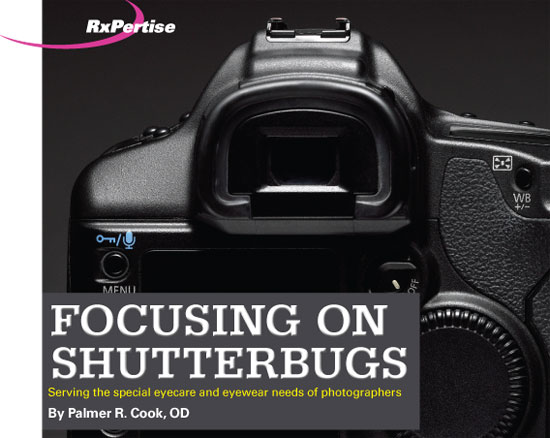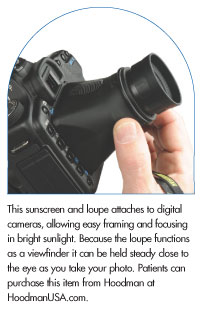
As eyecare professionals (ECPs), we deal with light and images all the time. Photographers also deal with light and images, and not surprisingly, whether they are novices, expert amateurs or professionals, their vision is the foundation of their art. While the images of most interest to us are retinal images, the images that most interest photographers end up on paper, computer screens and on television.
When you are doing a vision examination or designing eyewear from a current prescription, part of your responsibility lies in knowing the demands placed on your patient’s vision. Many of our patients have visual needs far beyond clear, comfortable vision at optical infinity and normal reading distances. In the press of today’s healthcare, perhaps less attention is paid to such needs than it was in the past. Photography, a craft enjoyed by many, raises some thought-provoking issues for eyecare providers who want to fully exercise their skill and knowledge.
VISUAL DEMANDS
Of course clear vision is needed for distance, and clear near vision is needed for making camera adjustments, but photographs are taken at all distances, so the lenses must be designed to accommodate that need. Color is a sensitive topic for all photographers, so color vision should be given consideration in both examining and designing the photographer’s working eyewear. The best possible retinal image is of primary importance, when evaluating an image on a screen, framing a subject to be photographed or focusing through a viewfinder.
We have all seen cartoons and photos of old-time photographers crouching behind a portrait camera with a black drape over his head. The black drape was needed because the task is to compose and focus a low intensity image cast upon a ground glass plate. If you have used a digital camera or camera phone in bright sunlight, you might think the art and science of photography have come full circle.
Aside from shading devices to block ambient light, there is no tint, dioptric prescription or lens design to overcome the problem of sunlight on a digital camera screen. In the early days of digital photography, manufacturers quickly recognized this problem, and digital cameras were equipped with viewfinders. Although as brighter screens became available viewfinders were eliminated from the lower end cameras, skilled photographers recognized that viewfinders were still needed for top-notch results.
VIEWFINDERS
Viewfinders are used for both focusing and framing or composing the picture. Through-the-lens viewfinders give an exact view as it will appear in the photo, while less expensive cameras have viewfinders that do not employ the primary optical system of the camera and only approximate the image that will be taken. In either case, some manufacturers give their nonadjustable viewfinders a power of -1.00 unless the viewfinder has an adjustable dioptric power.
For photographers with adjustable dioptric power viewfinders, Nikon admonishes, “Be careful not to knock or poke your eye when performing this adjustment.” (I think we all would agree that this is a commendable exercise of corporate responsibility.) The optical power of the viewfinder is usually not a problem for non-presbyopes unless they have a high refractive error, but photographers over 40 usually find nonadjustable/noncompensated viewfinders challenging, annoying and frustrating.
Several alternatives are available to compensate for presbyopia. Myopic photographers may simply remove their eyewear, but this is not a preferred solution for experienced action photographers who usually sight with one eye while keeping the other open to track peripheral activity. Dioptric adjustments are available to give varying amounts of plus and in many cases even minus power. Also, some manufacturers can supply compensating viewfinder adds, although these are only available in a limited range of spherical powers. Titanium frames are available with eyewires that can be flipped up individually, so the photographer can use the lenses or not depending upon need. Lenses with upper adds can also be employed to allow easier use of viewfinders by presbyopes. These can be helpful because photographers who wear glasses usually look through the upper and slightly lateral area of their right lens when using a viewfinder, but there are exceptions.
FOCUSING
 Today’s infrared focusing makes automatic focusing easy, and higher end cameras have focusing systems that can capture specific areas of the view and hold it in focus. Photographers with mildly impaired vision may find that using a range finder system similar to the double-to-single system used in the keratometer is a better way of manually focusing.
Today’s infrared focusing makes automatic focusing easy, and higher end cameras have focusing systems that can capture specific areas of the view and hold it in focus. Photographers with mildly impaired vision may find that using a range finder system similar to the double-to-single system used in the keratometer is a better way of manually focusing.
Although some cameras can compensate for limited amounts of camera movement at the moment the shutter is tripped, most casual camera users find it easier to steady the camera while using a viewfinder close to his or her eye rather than holding it out while viewing the screen. The implication for ECPs is that if your presbyopic patient wants or needs to use a viewfinder without a diopter adjustment, some creative eyewear design may be required.
At this time professional quality light field cameras are not yet on the market, but this technology may eliminate the need for focusing when taking photographs. These amazing point-and-shoot cameras essentially capture a wave front that is then downloaded to a computer. The photographer then selects the area of the picture that should be in focus. With special software, the information from the camera can even be used to produce 3-D photographs. For a peek at this fascinating technology, go to lytro.com/living-pictures.
FRAMING
Framing is the term photographers use to describe positioning the camera so the picture will include the intended objects or subjects. If the eye is positioned too far from the viewfinder’s aperture, the peripheral image will be blurred or not visible. This can be especially troubling for patients with long vertex distances. The nose can also be a factor, causing the patient to turn his head to get close enough to the aperture. Using the flattest practical base curve and/or a frame with moderate wrap may help. Also, if the lenses are primarily for photography and the Rx is strong, you may choose to move the MRPs higher to accommodate the situation. Your professional judgment and clear communication with the patient must be employed when making such decisions. The option of contact lenses should also be considered.
SUNGLASSES, ASTHENOPIA AND PHOTOGRAPHY
Professional photographers often spend long hours at the computer editing their work, so computer lenses or single vision lenses should be discussed. Using single vision clear lenses with some plus (even for pre-presbyopes) for editing tasks can reduce fatigue, and prescription polarizing sun lenses for driving may help avoid asthenopia.
Although the selective elimination of reflected glare makes polarizing sun lenses the premier choice for sun protection, this introduces some issues if they are used for photography. The screens of digital cameras emit light that is either polarized linearly with the axis of polarization vertical (when the screen is in landscape orientation), or obliquely at 45 or 135 degrees, or the emitted light is circularly polarized. When the axis of polarization is vertical, polarizing sunglasses do not interfere, but when the camera is rotated to a portrait orientation, the screen is virtually blocked. When the axis of polarization is oblique, the screen will be viewable in either landscape or portrait mode, but the brightness will be less than if the polarizing axis was vertical with the screen in landscape orientation. The circularly polarized screens will have only a minimal change in brightness as the screen is rotated. Because of these effects, you might offer to check the screen of your patient’s camera with a polarizing lens before ordering the sunglasses.
FOGGING
Although spectacle lens fogging is not a common complaint among casual photographers, professional photographers who specialize in events such as weddings and indoor social gatherings experience this problem when they use their viewfinders. Essilor’s new anti-fog, AR lens could be an ideal solution for this problem. An alternative could be to recommend anti-fog cleaner, but these products do not work well on AR lenses, and giving your patient the very best retinal image when he or she needs it most means using a top quality anti-reflective lens.
 SPECIALTY FRAMES
SPECIALTY FRAMES
A few specialty frames are available that allow lenses to be flipped up and out of the way. At least one of these frames is specifically designed for photography (see right). Because action photographers prefer to keep both eyes open when using a viewfinder, a frame that permits flipping one lens up for the viewfinder while leaving the other in place may be a welcome solution. Also, a viewfinder’s dioptric adjustment may serve a hyperopic or myopic patient’s needs better than a spectacle lens, and the convenience of being able to simply flip the spectacle back down for making camera adjustments and normal viewing could be very important to a professional photographer.
PRESCRIBING AND EYEWEAR DESIGN TIPS
Some lens treatments are beneficial for photographers, while others are a hindrance. For example, precise color rendering, manual focusing, framing and evaluation of ambient lighting makes the use of photochromic lenses and light tints generally inadvisable for highly skilled photographers. However, anti-reflective lenses are especially important for photographers, because these patients are often very visually discriminating, and anti-reflective lenses improve the performance of every lens design and every prescription.
Anti-reflective products do not all have the same resistance to abrasion, and frequent, prolonged contact of the spectacle lens surface against the viewfinder aperture is a cause for annoying, fine scratches. Your lab should be able to tell you which AR products have the greatest resistance to abrasion.
MRP placement can be critical, especially in midrange and higher prescriptions. Caution: Your lab will place the MRP for single vision lenses at the mounting line unless you specify otherwise. The placement of segs must be carefully considered, especially if the seg is to be used when employing the viewfinder. Measurements for progressive lenses might be taken with the chin slightly tucked downward in order to bring the near reference point a bit higher in the finished lenses.
Photographers make up only one category of patients with special vocational and avocational needs that can benefit by careful and creative use of today’s excellent ophthalmic technology. Your pre-examination or pre-eyewear design questionnaire can help uncover these needs, and addressing them can be an excellent way of building your practice.
Special thanks are extended to the following photographers for their technical advice and assistance: Chris Gampat, editor-in-chief, The Phoblographer; Laurie Nock, owner, Lamprints Gallery and Photographic Studio; Andy Hitz, Cord Camera, Cincinnati, Ohio; and Zivan Mendez, Cord Camera and professional photographer under the name Vortex-Interactive.
Palmer R. Cook, OD, is director of professional education at Diversified Ophthalmics, Cincinnati, Ohio.












